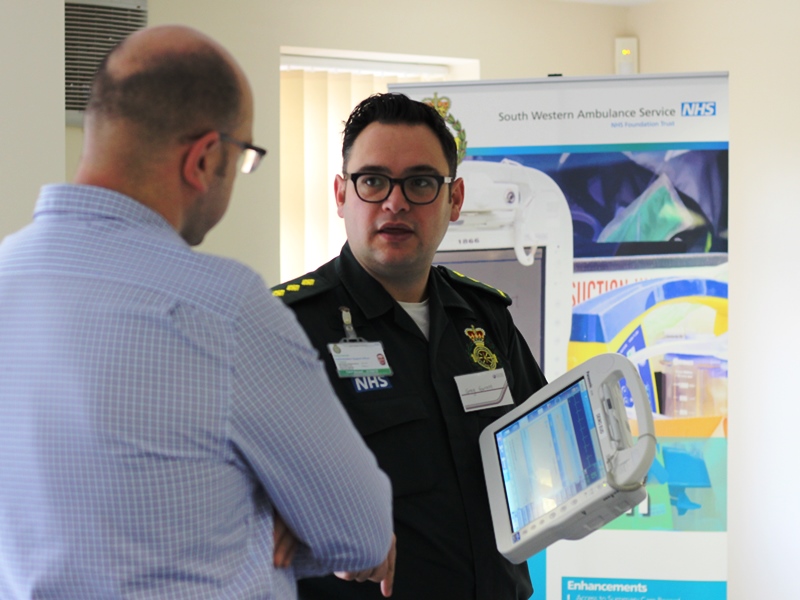
This spring, the South Western Ambulance Service (SWASFT) launched a new electronic Patient Care Record (ePCR) with Weston Area Health NHS Trust – an electronic solution designed by paramedics for paramedics.
19 emergency vehicles have been fitted with the ePCR device and 14 clinical workstations have been installed at five receiving units at Weston General Hospital. 98 SWASFT clinicians have been trained in using the new kit.
This is an exciting development for our ‘Safer Care through Early Warning Scores’ as NEWS (National Early Warning Score) will be automatically calculated, recorded and communicated for all patients using the portable monitoring equipment.
Led by Francis Gillen, Executive Director of IM&T, and clinically managed throughout by Dave Partlow, East Division Clinical Development Manager, SWASFT has over the last three years, worked tirelessly on the development of an Electronic Care System finally fit for a modern 21st century ambulance service.
The ePCR will enhance patient experience, support the decision-making process of frontline clinicians and open up opportunities for the transmission of data being captured to help improve SWASFT’s overall operations.
Background
The ECS has been created in partnership with Ortivus, a leading supplier of mobile solutions for modern emergency medical care. The solution aims to eradicate paper-based data collection, enhance the clinical decision making process and support the provision of ‘right care in the right place at the right time’.
The project was initially part of four work programmes led by Connecting for Health and aimed to provide an electronic solution across the South of England. Although looking in particular at an ambulance based solution, functionality to support further integration at a later stage has been a consideration throughout.
David Partlow says, “We wanted to find a system that is highly configurable by the ambulance service and a solution that is focused on the needs of a modern 21st century ambulance service. We wanted a service driven by the provision of high quality care and the desire to ensure that the patient outcome meets the needs of the individual patient, but is also focused on supporting the clinician in determining the most appropriate pathway and providing care that meets the objectives of the wider urgent care agenda.
How the ePCR was designed
The ePCR has been configured by a small but very dedicated project team in SWASFT. Using a structured model of examination and assessment, the software is configured so as to take the clinician through a structured process, capturing any and all clinical interventions and where possible and appropriate incorporating validated assessment tools to enhance the clinical decision making process. This in turn allows the clinician to use the solution to support
their clinical assessment and ensure that patients are conveyed or signposted to the most appropriate service.
The solution offers full connectivity at a clinical workstation, connecting the individual end user device via the 3G network. This allows the acute trust and other clinical partners to view the appropriate record and provide early indication of potential patients with regards levels of acuity and likely interventions. The solution is expected to provide for full NHS Spine connectivity and therefore supports the Summary Care Record.
Information Governance requirements feature heavily in SWASFTs requirements and there was a clear need for patient identifiable data to be held securely and only made available to those with a clinical need to see it. Data is only held on the end user device during the patient engagement; once closed and signed the data is held securely on a hosted server and cannot be accessed by anyone unauthorized to do so.
The capture and controlled transmission of patient data is available in the form of highly configurable output forms. This can be created and auto populated from data already entered, to enable Falls Referrals, TIA Clinic Referrals, Safeguarding Referrals and other suitable clinical outputs which further enhance the patient outcome and patient
experience.
The device incorporates a web browser, enabling the clinician to view a selection of approved websites such as toxbase, Athens and NICE. The device also holds a number of hard file documents, such as JRCALC, other national and local guidelines, Patient Group Directions and Operational Instructions.
The solution can and will also enable access via web links to the Directory of Services. Crews are often unaware of the options available to them to enhance the appropriateness of conveyance and this will greatly enhance the ability of SWASFT to build on its Right Care agenda, increasing the appropriateness of conveyance and decreasing the numbers inappropriately conveyed to the emergency departments.
What the future holds
The benefits of the device relate to enhancing the patient experience, supporting the decision making process and opening up real opportunities for the transmission of data. But equally important is the data that will be captured by SWASFT in relation to its operations. Such data will enable real opportunities in terms of research in to pre hospital care, research that up to this point has been incredibly onerous and reliant on review of paper based systems.
Posted on April 30, 2016


